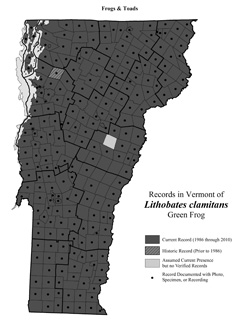Lithobates clamitans
Green Frog
Identification
The Green Frog is one of the three green-faced frogs in Vermont (the others are the Mink Frog and the Bullfrog). It is quite variable in color and pattern. Its body is a mottled green and brown with a green upper lip, dorsolateral ridges, and stripes across its legs. Their average size is between 2½-3½ inches long but large adults can reach 4¼ inches. Adult breeding males have a yellow throat, swollen thumbs, and eardrums (tympana) that are larger than their eyes.
The Green Frog’s call is often described as a “gulp” or the plucking of a loose banjo string. It may be heard April through July, peaking at the start of July.
The eggs are laid in a film that spreads over the water’s surface. The film can be up to a foot in diameter. Tadpoles spend one or two winters under the ice before metamorphosing.
Range/Habitat
This species lays their eggs in permanent still water with emergent vegetation.
Status
The Green Frog is a very common frog that has been found in almost every town in Vermont. It has a state natural heritage rank of S5 (common). Please report sightings of this species in Vermont if you have not reported them within the last five years from a given location. Any natural history observations (feeding, migrations, road crossing areas, early or late season appearance, abnormalities, etc.) are appreciated. Photographs are always helpful, particularly if your report is the first report of this species from a town.
More Info
All the Vermont species listed in the Rana genus were reclassified into the Lithobates genus in 2007.
- Lithobates clamitans clamitans at Animal Diversity website
- Rana clamitans at Amphibiaweb
- Lithobates clamitans melanota at the CARCNET website
- Rana clamitans at the Yale Peabody Museum website
- Listen to it
at Animal Diversity (.mp3 format)
at CARCNET (.wav format)
at Frog Quiz (QuickTime format)
at Western Soundscape Archive (embedded player)
or at the Yale Peabody Museum (.wav format)
Species summary written by Kaile Burgess.
Lithobates clamitans egg mass

Photo taken by J. Andrews.


